“Writing is a question of finding a certain rhythm. I compare it to the rhythms of jazz. Much of the time life is a sort of rhythmic progression of three characters. If one tells oneself that life is like that, one feels it less arbitrary.”
– Francoise Sagan, French playwright
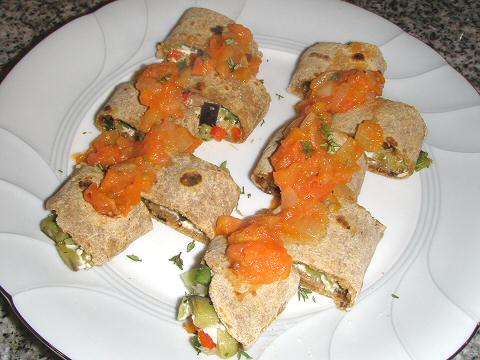
Buenos Aires – One of the questions I get asked the most, especially when I’m teaching classes, is a sort of “How do you get from point A to point B?”…. Starting from reading about a dish, or a recipe in a book or magazine, or looking at an ingredient, where does the idea for the final dish come from? Here’s the short answer – I don’t have a clue. But the longer answer is, that there’s generally some sort of process, sometimes actually in front of me, working with ingredients, and some part of it just happens internally, in the back of my brain. A lot of the latter comes, I’m sure, from being a committed bookworm – I read everything about food and wine that I can get my hands on – cookbooks, magazines, newspapers, you name it. And somewhere, in the dim recesses of cognitive function, connections are made between different things that I’ve read about, seen, tasted, worked with… and it leads me from one spot to the next.
I was flipping through a cookbook that I just recently got a copy of, Mangoes & Curry Leaves, by Jeffrey Alford and Naomi Duguid – what looks to be a fascinating journey through the “Great Subcontinent”, i.e., India, Bangladesh, Nepal, Pakistan, and Sri Lanka. I haven’t gotten to sit down and read it, but I was flipping through it specifically because of the interesting dinner my family and I had at Banjara a week ago – and I was curious to find more information about the specific type of cuisine. There was a single page writeup on the people of Banjara somewhere in the middle of the book, but nothing listed in particular about their food. And then I spotted, on page 126, a recipe for Cumin-Flecked Skillet Breads. It just caught my eye, and I stopped to read about the skillet breads, and this one in particular… it required whole cumin seeds and atta flour (a type of flour specifically milled for making these types of breads), neither of which I had; then cayenne, salt, ghee (or melted butter), and hot water, all of which I did have…
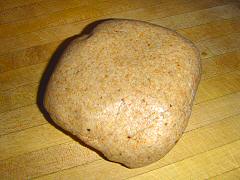 That led to looking up atta flour, first in the book’s glossary, which was of little help other than a definition, and then onto the internet looking for more information, along with possible substitutions – which, by odd coincindence involved a blend of white and whole wheat flours along with malted barley flour… I mean, who keeps malted barley flour in their kitchen… except, I was in Chinatown the week before my vacation and saw a small bag of malted barley flour and picked it up thinking, hmmm, this could be fun to play with in making some kind of bread… and while I didn’t have any whole cumin seeds, just ground, I did just pick up a little container of fennel seeds… which had me now thinking not Indian, but Italian, and those great semolina and fennel breads that I miss from New York…
That led to looking up atta flour, first in the book’s glossary, which was of little help other than a definition, and then onto the internet looking for more information, along with possible substitutions – which, by odd coincindence involved a blend of white and whole wheat flours along with malted barley flour… I mean, who keeps malted barley flour in their kitchen… except, I was in Chinatown the week before my vacation and saw a small bag of malted barley flour and picked it up thinking, hmmm, this could be fun to play with in making some kind of bread… and while I didn’t have any whole cumin seeds, just ground, I did just pick up a little container of fennel seeds… which had me now thinking not Indian, but Italian, and those great semolina and fennel breads that I miss from New York…
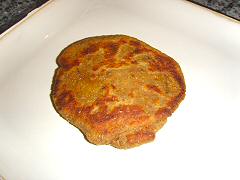 So the dough became a mix of equal parts of white flour, whole wheat flour, semolina flour, and malted barley flour, ¼ cup of each to be exact, plus two teaspoons of lightly toasted and then coarsely crushed fennel seeds, ½ teaspoon of cayenne flakes, a teaspoon of salt, a tablespoon of melted butter, and a cup of hot water. I then kneaded it together until it was all nice and smooth, and set it aside for an hour to rest. Now, after resting, both the bread and myself, the next step was simply to break off a small ball of the dough, form it into a disc – by hand, not rolling it out, according to the authors – less than ¼” thick, and simply fry it up in butter. It came out tasty, but, well, oily, as chapathi style breads often do – all that butter you know – I realize it’s the point of the type of bread, but…
So the dough became a mix of equal parts of white flour, whole wheat flour, semolina flour, and malted barley flour, ¼ cup of each to be exact, plus two teaspoons of lightly toasted and then coarsely crushed fennel seeds, ½ teaspoon of cayenne flakes, a teaspoon of salt, a tablespoon of melted butter, and a cup of hot water. I then kneaded it together until it was all nice and smooth, and set it aside for an hour to rest. Now, after resting, both the bread and myself, the next step was simply to break off a small ball of the dough, form it into a disc – by hand, not rolling it out, according to the authors – less than ¼” thick, and simply fry it up in butter. It came out tasty, but, well, oily, as chapathi style breads often do – all that butter you know – I realize it’s the point of the type of bread, but…
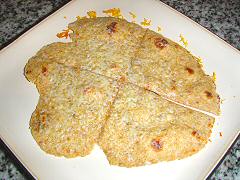 The authors had mentioned that they really liked this bread almost like a sandwich, filled with “hard cheese”… and that their kids like the bread with peanut butter… hmmm… not the latter thank you. Besides, two pieces of this bread seemed like a heart attack waiting to happen… What if I roll it out really thin and then fry it… no, wait, why fry it? I’m looking to lower the oiliness, if I make it really thin, why not just cook it dry – something like a naan or a tortilla? So I heated up a cast iron pan until it was very hot, rolled another ball of the dough out very thin, and then tossed it in the pan. When it was lightly browned on the underside, I flipped it, and following on the authors’ idea, grated some reggianito cheese over it and cooked it until the cheese melted. Now that’s really good – but it’s missing something. It’s a nice snack sort of thing, but the cheese is almost too strongly flavored for the fennel bread…
The authors had mentioned that they really liked this bread almost like a sandwich, filled with “hard cheese”… and that their kids like the bread with peanut butter… hmmm… not the latter thank you. Besides, two pieces of this bread seemed like a heart attack waiting to happen… What if I roll it out really thin and then fry it… no, wait, why fry it? I’m looking to lower the oiliness, if I make it really thin, why not just cook it dry – something like a naan or a tortilla? So I heated up a cast iron pan until it was very hot, rolled another ball of the dough out very thin, and then tossed it in the pan. When it was lightly browned on the underside, I flipped it, and following on the authors’ idea, grated some reggianito cheese over it and cooked it until the cheese melted. Now that’s really good – but it’s missing something. It’s a nice snack sort of thing, but the cheese is almost too strongly flavored for the fennel bread…
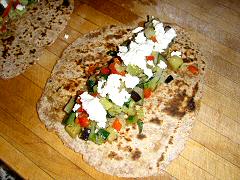 And so, hmmm… what’s in the refrigerator? Lots of good vegetables, and, as I usually have, things in the Mediterranean vein… fennel… wait, what about a sort of ratatouille-ish topping – the dish is certainly in the minds of every foodie out there with the current Disney movie – maybe a small dice of fennel, zucchini, eggplant, red bell pepper, hmm… all my garlic is soft and squishy… not good, but there are some shallots, so toss those in the pan, some chopped parsley, all cooked in just a touch of olive oil, salt and pepper to taste… top the dry cooked bread rounds… oh, there’s some fresh goat cheese, dollop a little of that atop… and wrap the whole thing up, and throw it in a hot oven just to melt the goat cheese and finish browning the outside of the breads… and maybe a little sauce – just some coarsely chopped onion and tomato, cooked just enough to soften them up, and then quickly hit with the hand blender, not to puree, but just to sort of smooth it out to more of a chunky sauce… slice the wraps, array on the plate, top with some sauce and a scattering of fresh thyme leaves… and there’s the dish in the picture up top… and delicious too…
And so, hmmm… what’s in the refrigerator? Lots of good vegetables, and, as I usually have, things in the Mediterranean vein… fennel… wait, what about a sort of ratatouille-ish topping – the dish is certainly in the minds of every foodie out there with the current Disney movie – maybe a small dice of fennel, zucchini, eggplant, red bell pepper, hmm… all my garlic is soft and squishy… not good, but there are some shallots, so toss those in the pan, some chopped parsley, all cooked in just a touch of olive oil, salt and pepper to taste… top the dry cooked bread rounds… oh, there’s some fresh goat cheese, dollop a little of that atop… and wrap the whole thing up, and throw it in a hot oven just to melt the goat cheese and finish browning the outside of the breads… and maybe a little sauce – just some coarsely chopped onion and tomato, cooked just enough to soften them up, and then quickly hit with the hand blender, not to puree, but just to sort of smooth it out to more of a chunky sauce… slice the wraps, array on the plate, top with some sauce and a scattering of fresh thyme leaves… and there’s the dish in the picture up top… and delicious too…
Hmm… maybe some olives, yes, black olives next time…
See, all very (il)logical, yes?